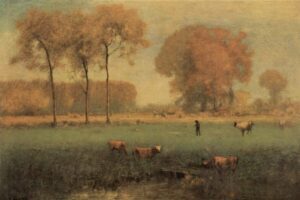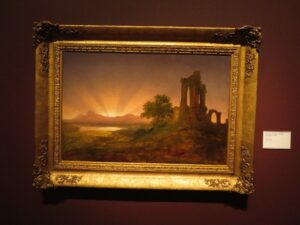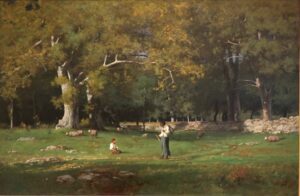The Hudson river school isn’t just a place—it’s a pivotal movement that shaped America’s artistic landscape.
It’s where nature’s grandeur met the canvas, giving birth to a unique vision of the American wilderness.
We’ll take you back to the mid-19th century when a group of painters, inspired by romanticism, began portraying the Hudson River Valley and surrounding areas with a new fervor.
Their work didn’t just capture landscapes; it stirred souls and awakened a nation’s pride in its natural beauty.
Let’s explore how these artists influenced generations and why their legacy endures in the world of art.
Origins Of The Hudson River School
The Hudson River School first emerged as a defining force in the art world during the early 19th century.
Rooted deeply in romanticism and an escalating appreciation for natural beauty, this movement represented a shift in American art away from portraiture and historical subjects.
Central to its ethos was the sublime – a concept that emphasized the awe-inspiring, transcendent power of nature.
Artists like Thomas Cole, who many regard as the founder of the School, were instrumental in shaping the movement’s direction.
He and his contemporaries traveled extensively, sketching and painting landscapes that showcased not just scenery but an emotional resonance birthed from their experiences in the wild.
Their work became synonymous with a burgeoning national identity and a celebration of the unique splendors found in the American landscape.
Works such as Cole’s The Oxbow and Frederic Edwin Church’s Heart of the Andes encapsulated the quintessential elements of the Hudson River School:

- Luminism, characterized by attention to light and detail, often creating a calm, reflective mood,
- Manifest Destiny, suggesting that the expansion of the United States across the American continents was both justified and inevitable,
- Immensity of landscape, illustrating the vast, untamed wilderness that was seen as a defining feature of American geography,
- A moral undertone, wherein the paintings were seen as works promoting virtuous ideals and an appreciation for God’s creation.
These paintings did more than present a visual spectacle; they became narrators of a story in which nature was both the protagonist and a boundless source of inspiration.
As we jump deeper into the individual ideologies and stylistic nuances of the Hudson River school artists, it’s clear that their collective vision transcended mere representation, influencing generations of artists and filmmakers who’d seek to capture the essence of a landscape or essence of an era in their work.
The Influence Of Romanticism
Romanticism as a movement deeply imbued the Hudson River School with a profound sense of the sublime.
This philosophical concept – the idea that natural grandeur can inspire a sense of awe and even spiritual reflection – formed the bedrock of Romantic art and was a fundamental aspect of the Hudson River School.
The movement transformed the larger-than-life American landscapes into canvases of emotional power and majesty.
The romantic era was distinguished by its emphasis on emotion and individualism as well as glorification of the past and nature.
Hudson River School artists drew from these romantic ideals to interpret and portray the American wilderness.
For us filmmakers, it’s akin to when we aim to capture a shot that conveys more than the sum of its visual elements, seeking a connection with the viewer’s innermost feelings.
- Interplay of light and shadow to produce moody atmospheres,
- Use of dramatic skies and waterways that seem to mirror human emotions,
- Selection of settings that suggest narrative depth and historical significance.
In the art of storytelling through film – our prime avenue of expression – we, too, imbibe similar ideals when we frame the timeless battle of light against dark or man versus nature.
The Hudson River School artists were among the first to embed these narratives within landscapes, and their legacy continues in the visual storytelling that we cherish and practice today.
Capturing The Beauty Of The Hudson River Valley
The Hudson River Valley has long served as a profound source of inspiration for artists, and the Hudson River School was no exception.
Its practitioners elevated this locale to near-mythic status through their canvases, deeply moving 19th-century audiences with their portrayals.
The landscapes were not mere replicas but infused layers of meaning – the serene and powerful beauty of nature, American progress, and a divine presence.
Artists of the Hudson River School ventured into the wilderness to seek out the most sublime sceneries the valley offered.
They delved deep into the Catskill, Adirondack, and the White Mountains, translating their awe into masterpieces that continue to resonate.
Works like The Oxbow and Heart of the Andes are testament to their ability to perceive and present nature as an expansive, untamed force.

Key characteristics of these works include:
- Dramatic use of light and shadow,
- Detailed, panoramic views of the landscape,
- A sense of scale that emphasizes nature’s grandeur.
Through our lenses as filmmakers, we appreciate the dramatic interplay of light and perspective that these paintings exhibit, principles that are foundational in our own craft.
The way the Hudson River School’s artists manipulated visual elements to guide the viewer’s emotions parallels our work in visual storytelling, where framing and lighting are instrumental in conveying meaning.
The influence of the Hudson River School extends beyond the canvas, as filmmakers draw upon the same sensibilities that stirred these artists.
Just as they captured the valley’s esoteric qualities, we strive to emulate this depth in our films, bringing the intangible essence of emotion and narrative into every frame.
The Hudson River Valley, with its rich tapestry of light, color, and texture, provides an archival blueprint for storytelling that transcends mediums, making it as relevant today as it was centuries ago.
Exploring The Surrounding Areas
The Hudson River School not only encapsulates a movement but also a geographical marvel.
We often wander along the same pathways taken by the likes of Thomas Cole and Frederic Edwin Church, seeking inspiration from the sights that sparked a revolution in American landscape art.
These artists uncovered the majestic beauty that lay in the Catskill Mountains, the Adirondacks, and the White Mountains – capturing them with a reverence that forever changed artistic perception.
In our own explorations, it’s not hard to see why the Hudson River Valley was ideal for this art movement.
With its diverse topography and fluctuating atmospheres, each location presents a myriad of elements that challenge us as visual storytellers.
Whether cloaked in the mist of morning or ablaze with the hues of sunset, the Hudson River scenery provides an entraordinary stage for both painter and filmmaker alike.
- Storm King Mountain offers sweeping vistas,
- Kaaterskill Falls reveals nature’s dynamic force,
- Olana, Frederic Edwin Church’s estate grounds, serves as a living canvas unto itself.
Itinerant by nature, Hudson River School artists underscored the importance of interacting with the landscape to understand its essence.
We advocate for a similar practice in filmmaking.
Just as Church’s Heart of the Andes delivered a lush and meticulously detailed vista that transports the viewer, we Try to capture scenes that wield the same immersive power.
The landscapes not only form a backdrop but also a character – potent and compelling in our visual narratives.
The symbiosis between the Hudson River School artists and their environment taught us the potency of reflection and observation.
For us in filmmaking, scenes shot in natural light, much like the ones these artists painted, often carry a breath of authenticity, evoking an unspoken narrative that unfolds within the hearts of audiences everywhere.
Through our lenses, the legacy of the Hudson River School persists, fostering an ongoing dialogue with nature and reinforcing the indelible link between environment and expression.
Impact And Legacy Of The Hudson River School
The Hudson River School artists significantly shaped American visual culture, instilling a reverence for natural landscapes that endures in diverse creative fields.
Their influence extends beyond canvas and oils, entrenched in the nationial consciousness as a cornerstone of environmental appreciation.
Through masterful depictions of light and atmosphere, they’ve left an indelible mark on the way we perceive our natural world.
The ethos and aesthetics of the Hudson River School ripple through time, affecting not only fine arts but also contemporary filmmaking.
- Directors seek out the sublime landscapes that echo the dramatic backdrops of a Frederic Edwin Church painting. – Cinematographers strive to capture the luminism inherent in these scenes, transcending typical visual storytelling.
The reverence for nature fostered by the Hudson River School has also paved the way for conservation movements.
Artists and viewers alike became more conscious of the environmental riches portrayed in these works and their vulnerability.

This spurred early steps towards preserving America’s natural beauty, an effort that has only grown more vital with time.
Educational institutions use Hudson River School art to teach about American history, culture, and environmental studies.
In this way, the movement’s legacy is perpetuated generationally, ensuring that the values and vistas at the heart of these works continue to inspire and instruct.
Filmmakers harnessing natural light and landscapes find guidance in the principles laid down by the School’s founders.
In seeking authenticity and emotional resonance, we often mirror the sensibilities of the Hudson River School artists, proving that their vision is as relevant today as it was in the 19th century.
What Is Hudson River School In Art – Wrap Up
We’ve seen the enduring influence of the Hudson River School extend beyond the canvas, shaping our appreciation of the American landscape and our commitment to preserving it.
Their legacy lives on in classrooms and conservation efforts, reminding us of the profound connection between art and nature.
As we witness the School’s principles echo in modern cinematography, we’re reminded of the timeless power of visual storytelling.
The Hudson River School’s vision continues to inspire artists and nature enthusiasts alike, proving that art is not just a reflection of our world—it’s a catalyst for protecting and cherishing it.
Frequently Asked Questions
What Was The Hudson River School?
The Hudson River School was a mid-19th century American art movement embodied by a group of landscape painters whose aesthetic vision was influenced by romanticism.
These artists were known for their portrayal of the American landscape, particularly the Hudson River Valley.
How Did The Hudson River School Influence American Visual Culture?
The Hudson River School had a profound impact on American visual culture by emphasizing the majesty and significance of the natural landscape.
This aesthetic has found a place in various forms of cultural expression, from fine arts to contemporary filmmaking.
In What Ways Have Contemporary Filmmakers Been Influenced By The Hudson River School?
Contemporary filmmakers have been influenced by the Hudson River School through their choice of dramatic landscapes that echo the grandiosity and emotive qualities of the paintings by artists like Frederic Edwin Church.
What Role Has The Hudson River School Played In Environmental Conservation?
The reverence for nature that was central to the Hudson River School’s philosophy helped spur conservation movements.
Their art highlighted the importance of preserving America’s natural beauty which, in turn, played a role in the development of environmental consciousness and activism.
How Is The Hudson River School’s Legacy Used In Education?
Educational institutions use the Hudson River School’s art to teach about American history, culture, and environmental studies.
The art serves as a visual tool to discuss these themes and the School’s influence on the national appreciation of nature.


